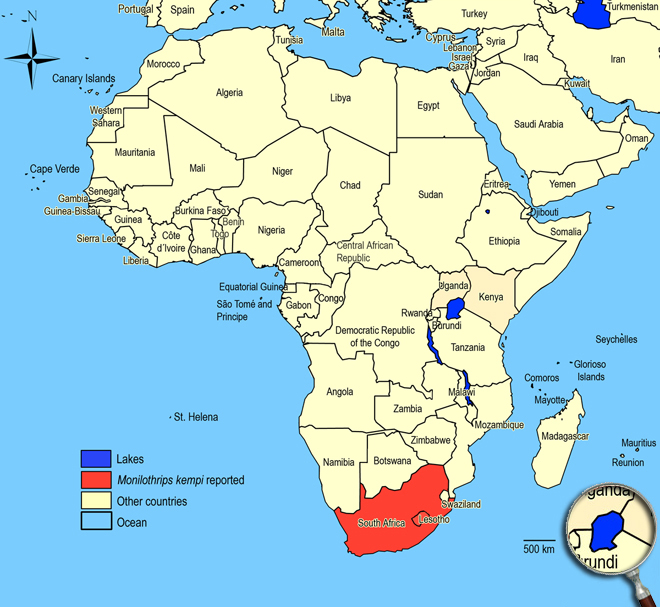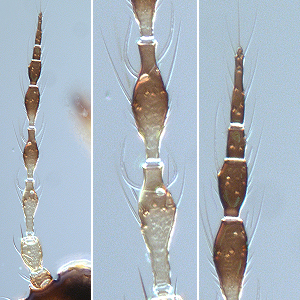Monilothrips kempi Moulton, 1929
Panchaetothripinae, Thripidae, Terebrantia, Thysanoptera
Figures
Fig. 1: 8-segmented antenna, segments III and IV with forked sense cone, terminal segments V-VIII
Fig. 2: Head dorsal with ocellar triangle
Fig. 3: Pronotum
Fig. 4: Meso- and metanotum
Fig. 5: Meso- and metasternum
Fig. 6: Fore wing and fore wing distal region
Fig. 7: Sternite VII and basal sclerites of ovipositor
Fig. 8: Segments 8-10 ventral with ovipositor
Fig. 9: Tergites VII and VIII
Fig. 10: Tergites VIII-XI
Introduction and recognition
Monilothrips kempi damages various ferns. Both sexes fully winged. Body dark brown; legs brown with base and apex of tibiae yellow, also tarsi; antennal segments I & III brownish yellow, II pale, IV & V yellow at base, VI-VIII dark brown; fore wings light brown with a pale patch subbasally and interveinal surface pale. Antennae 8-segmented; segments III & IV with forked sense cone, VIII twice as long as VII (Fig. 1). Head with a broad reticulated posterior collar (3 rows of reticles), long ocellar setae of equal length, and 3 pairs of prominent postocular setae (Fig. 2). Pronotum relatively smooth, with stout transverse carina parallel to posterior margin, 1 pair of long posteroangular and 1 pair of long anteroangular setae (Fig. 3). Mesonotum reticulate, not divided longitudinally. Metanotum reticulate medially; median setae near posterior margin; without median triangle of sculpture (Fig. 4 and 5). Mid and hind tarsi 2-segmented. Fore wing first vein close or fused to costal vein; veins with two complete rows of long setae; anterior margin with setae and cilia but setae longer than cilia and up to twice as long as wing width; posteromarginal cilia undulated (Fig. 6). Tergites II-VIII polygonally reticulate behind the thin antecostal line, median setae small, posterior margins with broad craspedum (Fig. 9); IX & X nearly smooth (Fig. 10); X with complete longitudinal split. Sternites each with 3 pairs of long setae close to posterior margin; sternite II & III with complete craspedum at posterior margin, also laterally on IV-VII.
Male smaller than female; with 2 pairs of thorn-like setae on tergite IX; without sternal glandular areas.
Taxonomic identity
Species
Monilothrips kempi Moulton, 1929
Taxonomic history
Monilothrips montanus Jacot-Guillarmod, 1942
Common name
-
Present taxonomic position
Family: Thripidae Stephens, 1829
Subfamily: Panchaetothripinae Bagnall, 1912
Genus: Monilothrips Moulton, 1929
Genus description
The genus Monilothrips Moulton, 1929
Only one species is placed in the genus Monilothrips which is widespread in India, California and southern Africa. Monilothrips kempi has 8-segmented antennae with forked sense cone on segments III and IV, a single long seta at each angle of pronotum, 2 complete rows of setae on the fore wing, fore wing anterior margin with setae longer than costal cilia, and a broad craspedum on posterior margin of tergites II-VIII. Compared to mostly other Panchaetothripinae surface of head, pronotum and fore legs is not strongly reticulated except the occiptal collar on head.
Species description
Typical key character states of Monilothrips
kempi
Coloration and body sculpture
Surface of head, pronotum and fore legs: without obvious or with weakly reticulate sculpture
Body color: mainly brown to dark brown
Sculptured reticles on head and pronotum: with no internal markings
Antennae
Form of sense cones on antennal segments III and IV: emergent and forked on segments III and IV
Number of antennal segments: 8
Terminal antennal segments: VI-VIII forming a single unit
Head
Cheeks shape: without constriction posteriorly
Head: not prolonged or distinctly prolonged in front of compound eyes
Ocelli: present
Head occipital collar: in contrast to rest of head heavy reticulate sculptured
Head - occipital ridge dorsally: present
Prothorax
Pronotal blotch or internal apodeme: absent
Pronotum shape: broadly rectangular
Mesothorax
Mesonotum: with an incomplete median division
Metathorax
Metanotum with dominant sculptured triangle medially: absent
Shape of metathoracic furca: transverse, V-shaped
Wings
Fore and hind wings: present, more than half as long as abdomen (macropterous)
Fringe cilia arising: from sockets
Fore wing veins: present
Fore- and hind wing surface: covered with microtrichia
Apex of fore wing: with prominent terminal setae
Fore wing anterior margin (costal vein): with setae and cilia but setae longer than cilia
Fore wing costal fringe cilia: arising at anterior margin of wing
Fore wing first vein: close to or fused to costal vein
Fore wing first vein setal row: complete, with setae closely and uniformly spaced
Fore wing second vein setal row: complete, setae uniformly spaced
Fore wing shape: mainly parallel sided or margins run continuously towards each other
Fore wing surface: not reticulate
Fringe cilia on posterior margin near apex: distinctly wavy (undulated)
Length of fore wing costal setae at middle of wing: about twice or more as long as median wing width
Shape of fore wing apex: with mainly posterior margin curved to join anterior margin
Fore wing extreme apex color: dark
Fore wings: pale with dark area(s)
Legs
Mid and hind tarsi: with two segments
Color of fore tarsi: pale or yellow with a dark apical ring
Abdomen
Tergite II: without specialised cuticles laterally
Tergites IV and V median setal pair: shorter than distance between their bases
Tergites V to VII: without ctenidia laterally, but sometimes with rows of microtrichia
Tergites VIII to X: without unusually long and stout setae
Tergites: without conspicuously dark, stout and long setae
Tergites: without distinctive tergal sculpture forming a series of arches on the antecostal ridges
Tergite X: not tubular, longitudinally incomplete
Setae on abdominal tergite X: all setae slender

Similar or related species
Monilothrips kempi is a distinct species and differs from most other Panchaetothripinae due to the surface of head, pronotum and fore legs which is not strongly reticulated except the occiptal collar on head, and the presence of 2 pairs of elongated pronotal setae. It is similar to the species of Hercinothrips in having 2-segmented tarsi and two complete rows of setae on the fore wing. But in Hercinothrips head and pronotum have reticulate sculpture, head constricted posteriorly, without a distinct occipital ridge, and without elongated pronotal setae. Furthermore, the species is similar to Panchaetothrips noxius in having 2-segmented tarsi, a distinct occipital ridge, and in lacking a posteromarginal comb of microtrichia on tergite VIII. But unlike Monilothrips kempi, in Panchaetothrips noxius the head shows a reticulate sculpture and is constricted posteriorly, without elongated pronotal setae, the metanotum has a weakly defined sculptured triangle medially, first vein setal row incomplete and second vein without setae, tergites with conspicuously dark, stout and long setae, tergite X elongate and tubular. Xestothrips glabratus has no strong reticulate sculpture neither on head nor on pronotum. Compared to Monilothrips kempi, this species has a posteriorly constricted head, pronotum without long setae, fore wings uniformly dark brown and with first vein setal row incomplete, 1-segmented tarsi, and tergite VIII with a complete posteromarginal comb of microtrichia. Compared to other Panchaetothripinae with a distinct occipital ridge, only in Monilothrips kempi the occipital collar shows in contrast to the other part of the head a heavy reticulate sculpture. In Xestothrips glabratus collar and rest of the head are similar sculptured. In Helionothrips errans and Panchaetothrips noxius the collar is weakly sculptured to the rest of the head. Like Monilothrips kempi, Panchaetothrips noxius and Selenothrips rubrocinctus have fore wing costal setae up to twice as long as wing width medially. In contrast, Selenothrips rubrocinctus has uniformly dark brown fore wings, 1 segmented tarsi, a complete posteromarginal comb on tergite VIII and a pronotum with transverse striate sculpture.
Biology
Life history
As with other thrips species the life cycle from egg to adult is dependent on temperature. The full cycle can take about 15 days to over a month and adults may live for more than one month producing several generations in one year depending on seasonal weather (Lewis 1973). With greenhouse temperatures the developmental time from egg to adult can decrease to about one week.
Host plants
Recorded from various ferns, including Blechnum australe, Adiantum aethiopicum, Polystichum sp., Hypolepis sparsisora.
Vector capacity
None identified, but possible mechanical distribution of phytopathogenic fungi and bacteria.
Damage and symptoms
-
Detection and control strategies
-
Additional notes
Larvae and adults feed on fern fronds.

Biogeography
India, USA. (California), southern Africa. Lesotho (Mamathes),
South Africa (Limpopo: Mariepskop).
African countries where Monilothrips kempi has been reported

The species Monilothrips kempi was not observed in surveys undertaken in East Africa on vegetables and associated weeds and crops.
Please click here for survey sites of all observed thrips species of Kenya, Tanzania and Uganda.

Bibliography
Hood JD (1959). A note on Monilothrips kempi Moulton (Thysanoptera: Thripidae). Journal of the Entomological Society of Southern Africa. 22 (2): 489-493
Jacot-Guillarmod CF (1942). Studies on South African Thysanoptera - III. Journal of the Entomological Society of Southern Africa. 5: 64-74
Kudo I (1992). Panchaetothripinae in Japan (Thysanoptera, Thripidae), 3. Monilothripini and Tryphactothripini. Japanese Journal of Entomology. 60 (3): 467-482
Lewis T (1973). Thrips: their biology, ecology and economic importance. Academic Press Inc., London Ltd., 349 pp
Moulton D (1929). Thysanoptera from India. Records of the Indian Museum. 31 (2): 93-100
Wilson TH (1975). A monograph of the subfamily Panchaetothripinae (Thysanoptera: Thripidae). Memoirs of the American Entomological Institute. 23: 1-354
zur Strassen R (1960). Catalogue of the known species of South African Thysanoptera. Journal of the Entomological Society of Southern Africa. 23 (2): 321-367
----
Web links
Mound´s Thysanoptera pages
Thysanoptera Checklist
ICIPE Thrips survey sites
UNI Halle & Thrips sites
Thrips of California













